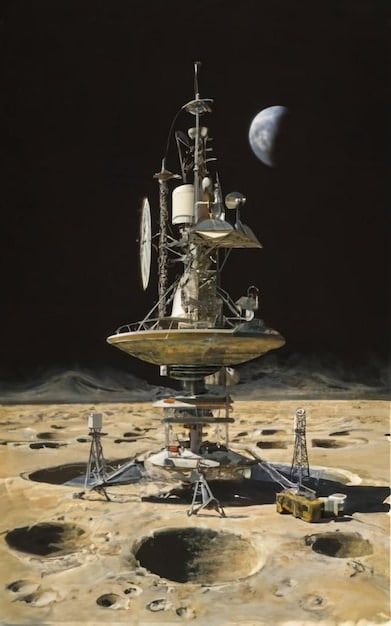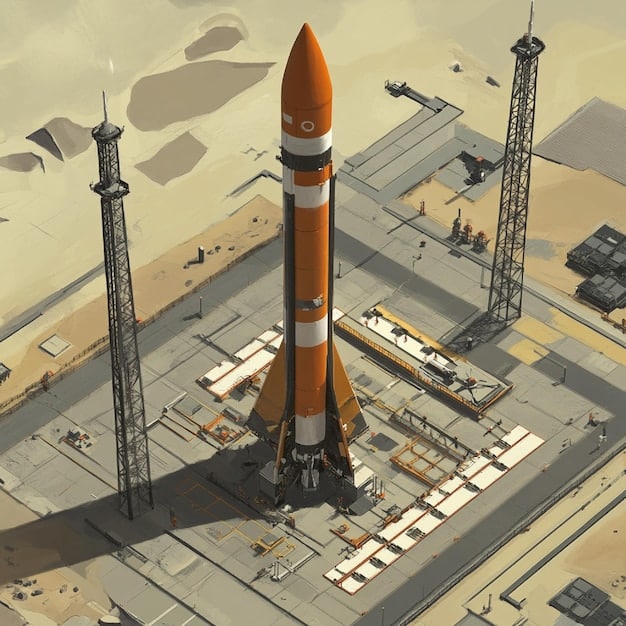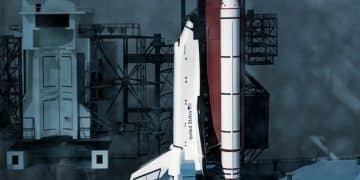Artemis Program Costs: NASA’s Budget and Future Space Exploration

What are the projected costs for NASA’s Artemis program through 2025, and how will this impact future space exploration budgets? The Artemis program aims to return humans to the Moon, but its escalating costs, estimated to be billions annually, could strain NASA’s overall budget, potentially delaying or reducing funding for other crucial space exploration initiatives.
The ambitious Artemis program, NASA’s endeavor to return humans to the Moon by 2025, has captured the world’s imagination. However, a crucial question looms large: what are the projected costs for NASA’s Artemis program through 2025, and how will this impact future space exploration budgets? This program, while promising groundbreaking scientific discoveries and technological advancements, comes with a hefty price tag that’s raising concerns about its potential impact on other vital NASA projects.
Understanding the financial implications of Artemis is essential for assessing the future of space exploration. The costs involved not only affect NASA’s budget allocation but also influence the prioritization of different missions and research areas. Let’s delve into the projected expenses and explore the potential consequences for the broader space exploration landscape.
Understanding the Scope of the Artemis Program
The Artemis program is more than just a return to the Moon; it’s a comprehensive initiative designed to establish a sustainable presence on and around our celestial neighbor. This involves developing new technologies, infrastructure, and partnerships, all of which contribute to its overall cost.
Key Components of the Artemis Program
Several key components contribute to the overall cost of the Artemis program. These elements are crucial for achieving the program’s goals and represent significant financial investments.
- Space Launch System (SLS): The heavy-lift rocket designed to send astronauts and cargo beyond Earth orbit.
- Orion Spacecraft: The crew module that will transport astronauts to and from the Moon.
- Human Landing System (HLS): The spacecraft that will land astronauts on the lunar surface.
- Gateway: A lunar orbiting platform that will serve as a staging point for lunar missions.
Each of these components requires extensive research, development, testing, and operational support, resulting in substantial financial commitments. The development and maintenance of these systems are critical for the success of the Artemis program but also contribute significantly to what are the projected costs for NASA’s Artemis program through 2025, and how will this impact future space exploration budgets?

In conclusion, the Artemis program encompasses a wide range of sophisticated technologies and infrastructure. Each element plays a vital role in achieving the program’s objectives, but their development and maintenance contribute significantly to the overall financial burden, affecting NASA’s budget and future space exploration endeavors.
Projected Costs of the Artemis Program Through 2025
Estimating the precise cost of a space program as ambitious as Artemis is a complex undertaking. Various factors, including technological challenges, unforeseen delays, and evolving mission requirements, can influence the final price tag.
Estimating the Artemis Budget
Multiple sources have provided estimates for the projected costs of the Artemis program. These estimates vary depending on the scope of the analysis and the assumptions made about future funding levels and program execution.
The NASA Office of Inspector General (OIG) has released reports outlining the projected costs for specific components of the Artemis program, such as the SLS and Orion spacecraft. These reports provide valuable insights into the financial challenges associated with these critical elements.
Congress has also played a role in shaping the Artemis budget through annual appropriations bills. The amount of funding allocated to the Artemis program each year can significantly impact its progress and overall cost. Understanding what are the projected costs for NASA’s Artemis program through 2025, and how will this impact future space exploration budgets? requires careful monitoring of congressional decisions.
Understanding the Nuances of Budget Estimates
It’s important to recognize that the projected costs of the Artemis program are not static. They can change over time due to various factors. Consider these points:
- Technological advancements can lead to cost savings or increased expenses.
- Unexpected technical challenges can cause delays and budget overruns.
- Changes in mission requirements can necessitate adjustments to the program’s scope and cost.
Therefore, it is crucial to analyze the budget estimates with an understanding of the inherent uncertainties and potential for change. In conclusion, projecting the costs of the Artemis program involves navigating a complex landscape of estimates and uncertainties. Careful consideration of these factors provides a more realistic understanding of the financial implications and helps to assess what are the projected costs for NASA’s Artemis program through 2025, and how will this impact future space exploration budgets?
The Impact on Future Space Exploration Budgets
The significant investment in the Artemis program will inevitably have repercussions for NASA’s overall budget and the allocation of resources to other space exploration endeavors. Understanding these potential trade-offs is crucial for evaluating the long-term sustainability of NASA’s mission.
Potential Trade-offs and Resource Allocation
The Artemis program’s budget demands can lead to potential trade-offs with other NASA projects and initiatives. This means that funding for certain areas may be reduced or delayed to prioritize the Artemis program. Here are some possible scenarios:
- Reduced funding for robotic missions to other planets.
- Delayed development of advanced space telescopes.
- Slower progress on scientific research related to climate change and Earth observation.
NASA must carefully balance the prioritization of the Artemis program with the need to maintain a diverse portfolio of space exploration activities. These choices dictate what are the projected costs for NASA’s Artemis program through 2025, and how will this impact future space exploration budgets? and the future of space exploration.
The Broader Impact on Scientific Discovery
The financial implications of the Artemis program extend beyond NASA’s budget. They also have the potential to affect scientific discovery and technological innovation in the broader scientific community. Consider the following:
Reduced funding for university research grants can limit opportunities for groundbreaking research in space-related fields.
Delays in the development of new technologies can slow the pace of innovation in areas such as propulsion, robotics, and materials science.
The program’s impact raises questions about what are the projected costs for NASA’s Artemis program through 2025, and how will this impact future space exploration budgets?
Ultimately, the long-term sustainability of space exploration depends on striking a balance between ambitious human spaceflight programs like Artemis and a robust program of scientific discovery and technological innovation. Careful consideration of these factors is essential for ensuring a vibrant and productive future for space exploration.

Alternative Approaches to Lunar Exploration
While the Artemis program represents a specific approach to lunar exploration, alternative strategies and technologies could potentially achieve similar goals at a lower cost. Exploring these options is essential for maximizing the efficiency and effectiveness of future space exploration efforts.
Exploring Alternative Technologies and Strategies
Several alternative technologies and strategies could be considered to potentially reduce the cost of lunar exploration. These include:
- Leveraging commercial partnerships to develop and operate lunar transportation systems.
- Utilizing smaller, more cost-effective rockets for specific mission requirements.
- Developing reusable spacecraft and infrastructure to reduce long-term operational costs.
These alternative concepts may offer opportunities to achieve similar scientific and exploration goals at a lower price point and influence what are the projected costs for NASA’s Artemis program through 2025, and how will this impact future space exploration budgets?
The Role of International Collaboration
International collaboration can be a powerful tool for reducing the cost and risk associated with space exploration. By pooling resources and expertise, nations can share the financial burden and accelerate the pace of scientific discovery. Consider these points:
Partnering with other space agencies can provide access to new technologies and capabilities.
Sharing mission responsibilities can reduce duplication of effort and lower overall costs.
International collaboration can foster goodwill and promote peaceful cooperation in space.
In conclusion, exploring alternative approaches to lunar exploration and fostering international collaboration can offer opportunities to reduce costs, share risks, and accelerate the pace of scientific discovery. By carefully evaluating these options, we can ensure that future space exploration efforts are both sustainable and impactful.
Balancing Ambition and Fiscal Responsibility
The future of space exploration hinges on finding a balance between ambitious goals and fiscal responsibility. The Artemis program represents a bold vision for human spaceflight, but its cost must be carefully managed to ensure the long-term health of NASA and the broader scientific community.
Promoting Transparency and Accountability
Transparency and accountability are essential for ensuring that taxpayer dollars are spent wisely on space exploration. This requires:
- Open and honest communication about the costs, risks, and benefits of the Artemis program.
- Independent audits and oversight to identify potential inefficiencies and cost overruns.
- Clear lines of responsibility and accountability for program management and execution.
With proper oversight, it is possible to see what are the projected costs for NASA’s Artemis program through 2025, and how will this impact future space exploration budgets?
Investing in the Future of Space Exploration
While managing costs is crucial, it’s equally important to invest in the future of space exploration. This includes:
Supporting research and development in key areas such as propulsion, robotics, and materials science.
Educating and training the next generation of scientists, engineers, and astronauts.
Fostering public engagement and enthusiasm for space exploration.
By investing in these areas, we can prepare for the challenges and opportunities that lie ahead, influencing what are the projected costs for NASA’s Artemis program through 2025, and how will this impact future space exploration budgets?.
In conclusion, balancing ambition and fiscal responsibility is essential for ensuring the long-term success of space exploration. By promoting transparency, investing in the future, and fostering a collaborative approach, we can unlock the vast potential of space while remaining mindful of the financial constraints and priorities that shape our endeavors.
| Key Point | Brief Description |
|---|---|
| 🚀 Artemis Program | Aims to return humans to the Moon by 2025. |
| 💰 Budget Concerns | High costs may impact other NASA projects. |
| 🤝 Collaboration | International partnerships can reduce costs. |
| 🔭 Alternatives | Exploring other technologies could lower expenses. |
Frequently Asked Questions
The primary objective of the Artemis program is to return humans to the Moon by 2025, with a focus on establishing a sustainable presence for future exploration and scientific discovery.
Projected costs vary but are estimated to be in the tens of billions of dollars. Specific figures are subject to change due to development and mission requirements. These costs are a major factor in what are the projected costs for NASA’s Artemis program through 2025, and how will this impact future space exploration budgets?
Due to its high cost, the Artemis program could potentially lead to reduced funding for other NASA missions, such as robotic explorations or climate research. Prioritization will be key.
Alternatives include leveraging commercial partnerships, using smaller rockets, developing reusable spacecraft, and fostering more international collaboration to reduce overall expenses.
Monitoring the budget helps ensure transparency, accountability, and efficient allocation of resources, and allows for informed decisions about what are the projected costs for NASA’s Artemis program through 2025, and how will this impact future space exploration budgets?
Conclusion
In conclusion, the Artemis program represents a significant financial undertaking for NASA. Understanding what are the projected costs for NASA’s Artemis program through 2025, and how will this impact future space exploration budgets? is vital not only for stakeholders but also for anyone interested in the future of space exploration.





